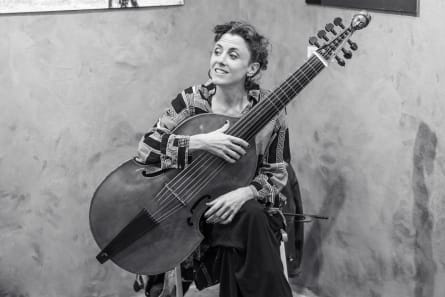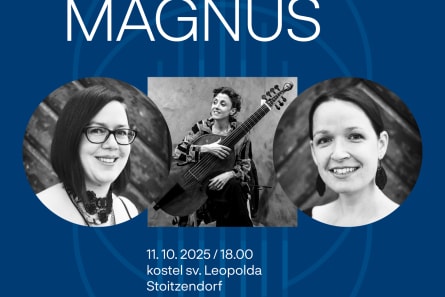Ecce, sacerdos magnus
Saturday, 11. 10. 2025 at 18:00
Church of St. Leopold
Stoitzendorf
A music and literary programme dedicated to the personality of Bishop Augustin Lucian of Mirandola – a clergyman, diplomat, and humanist who was active in Mantua, Prague, Kutná Hora, and Lipnice. Sacred and secular music from the 15th century will be performed by the ensemble **Musica Panica** (Eliška Baťová, Kristýna Kosíková, Melusine Srovnal, Vladimír Kosík), complemented by period texts and recitations. The programme includes compositions by authors such as Johannes Martini, Jacob Obrecht, Marco Cara, and anonymous chants that evoke the atmosphere of the late Gothic and early Renaissance. The concert takes place in the Baroque-Gothic church of St. Leopold, whose organ from 1805 will enhance the festive character of the evening.
This concert concludes the 6th edition of the Silberbauer’s Musical Thaya Region festival, which offers musical gatherings in beautiful sanctuaries across South Moravia and Lower Austria during August, September, and October 2025.
🗓️ 11th October 2025 (Saturday) | 🕔 18:00
📍 Stoitzendorf, Church of St. Leopold
🎟️ Voluntary admission
Künstler
- Musica Panica is an ensemble of professional female musicians dedicated to the interpretation of medieval and Renaissance music. It draws on international experience in the performance and study of early music. The ensemble has been active in the Czech Republic since 2020, when it introduced itself with a project reviving Czech love songs from the late medieval manuscripts of Kříž of Telč. The main driving forces of the ensemble are Kristýna Kosíková (clavisymbalum, organetto, harp), a graduate of the Academy of Performing Arts in Prague (HAMU) and international internships, a harpsichordist and member of numerous Czech and foreign ensembles, and Eliška Baťová (dramaturgy, flutes), a graduate of the Pilsen Conservatory and the Institute of Musicology at the Faculty of Arts, Charles University in Prague, a flautist, music teacher, and author of scholarly publications on early music. Mélusine Srovnal (vocals, viola da gamba, fiddle) is a graduate of the Maîtrise Notre-Dame de Paris and the Conservatoire National Supérieur de Musique de Paris; as a singer and gambist, she participates in numerous renowned projects both in the Czech Republic and abroad. Společně tentokrát představí komponovaný program Ecce, sacerdos magnus: Hudební obraz renesančního biskupa v husitských Čechách, sestavený z duchovních i světských skladeb 15. století. Osou tohoto programu je život a působení Augustina Lucianiho, italského biskupa, který ze svého působiště v Mirandole – centru tehdejší italské renesanční kultury – odešel do Čech, které byly po husitských válkách bez biskupa. Několik let zde konal „vítěznou pouť“, oslavován po utrakvistických městech, šlechtických sídlech a nakonec i v Praze, než jej spory s vedením církve donutily se stáhnout do ústraní. Zemřel v Kutné Hoře, do rodné Itálie se již nikdy nevrátil. Pro hudební ztvárnění je život této osobnosti nesmírně inspirativní: střetává se tu lehkost italské renesance s neklidným českým prostředím, které zní stále ještě tóny pozdního středověku. Soubor Musica Panica interpretuje v tomto projektu vokální i instrumentální skladby, které se k příběhu Augustina Lucianiho vážou. Kombinuje v nich zvuk fléten, clavisimbala, oraganetta, violy da gamba a fiduly s ženskými hlasy.
- Eliška Baťová – flutes, vocals
- Kristýna Kosíková – clavisimbalum, organetto, harp, vocals
- Melusine Srovnal – viola da gamba, vocals, fiddle
- Vladimír Kosík – recitation, vocals
Entritt
Voluntary admission
Programme
Johannes Martini: La fleur de biaulté
Recitation: In the year of our Lord 1482, the enemies of the chalice did not allow Czechs to be consecrated to the priesthood…
Johannes Martini: Fuge la morie
Johannes Martini: Il est toujours
Marchetto Cara: Chi me dara piu pace
Recitation: It has come to our attention that Your Highness is inquiring about our arrival in this kingdom…
anonym: Sampsonis honestissima / En etas iam aurea
anonym: Sacerdos et pontifex
anonym: Patrem omnipotentem
Recitation: And first he came to Lord Petr at Vinterberk, in the last week of Lent…
chorál: Tu es Domine
Recitation: And there many towns sent their messengers to him…
Johannes Martini: Sol mi fa sol sol
chorál: Iam non dicam vos servos
Recitation: In the year of our Lord 1484, Bishop Augustin, being gloriously received by the Praguers into Prague…
song: Let us praise God, always good
Jacob Obrecht: Largire nunc mitissime
Recitation: On Sunday, also on St. James’s Day, the same bishop served in the monastery of St. James in the Old Town…
Petrus Wilhelmi de Grudencz: Predulcis eurus turbinis
Reading from the Book of Wisdom
Song: Faithful Christians, hope strongly
anonym: Let us give praise to God
Recitation: In the year of our Lord 1491, Lord Bishop Augustin, having laid down the seal of the archbishopric…
Alexander Agricola: Cecus non judicat de coloribus
Recitation: In the year 1493, on the Friday before the translation of St. Wenceslas, the venerable father died in Hora…
Johannes Martini: De la bonne chierre
anonym: Marguerite
Bartolomeo Tromboncino: La pietà chiuso ha le porte
Ort
The parish church of Saint Leopold in Stoitzendorf, Austria, is a remarkable monument with roots dating back to the 15th century. Originally dedicated to St. James, it was annexed to the Klosterneuburg Monastery in the 16th century and acquired a new patronage – St. Leopold, the patron saint of Lower Austria. The current form of the church is the result of several construction phases. After being destroyed during periods of war, it was rebuilt in 1620, the tower was added in 1740, and in the 19th century, both the interior and exterior underwent significant modifications. The Gothic core of the building is still visible in the pointed windows and portals, while Baroque and Neo-Gothic elements shape its present character. Inside, the richly painted ceiling, Baroque sculptures of St. Peter and St. Paul on the main altar, and wooden statues of saints from the turn of the 18th and 19th centuries are particularly noteworthy. The organ, completed around 1805, deserves special attention and is still used for liturgy and concerts today.
Back to all concerts
